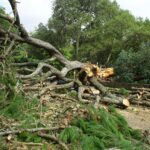At a glance
- The beauty of vegetation plantations extends beyond aesthetics; they contribute to societal well-being as well.
- Yet, rooting is one of the biggest problems in vegetation plantations.
- Factors to consider while plantation to avoid rooting problems.
Planting vegetation is the right way to add some green life to your home as well as beautify your landscape. Vegetation is often associated with beauty; however, they offer more than just aesthetic benefits. Along with improving the appearance of your home, they are also beneficial to the environment, helping it grow and clean the air.
Considering all the benefits of vegetation plantations, it is hard to believe they also have negative aspects.
Did you know that a vegetation plantation, even at the right spot in your yard, can have drawbacks? It’s, therefore, important to understand what their limitations are before growing these gentle giants on your property.
Vegetation plantations have a rooting issue that is one of their biggest problems. A vegetation plantation can experience two types of rooting problems. Either the roots are girdling, rotting, lacking moisture, or pests or diseases cause problems, or the roots cause problems somewhere else.
How far should you plant vegetation to avoid rooting problems?
For most people interested in vegetation planting, the main concern is how close/far they should plant from their homes to avoid root problems. A number of factors need to be taken into account, including:
Root Network
There can be some serious problems caused by disruptive roots. If you’re selecting a plant species and planting it in a specific location, it is important to consider the spread of the root network and the type of roots. A plant with lateral roots, such as the Moreton Bay Fig, will need to be planted farther away from your home to avoid problems. In addition, heart and oblique root systems tend to grow deeper rather than wider, so making sure they are planted over utility pipes or other vital underground infrastructure is important.
Size of your garden
You also need to determine the size of your garden. Get an idea of how spacious your garden is and how far you want your plant to be from your house. Even if you think you have the perfect spot, if it is directly next to any kind of foundation, you should reconsider.
Size of your plant
Plants (including trees) are not just measured by their height. It is also important to consider the trunk size and canopy of the tree when determining how far to plant it. For trees over 6 meters in diameter, you should plant them at least half the diameter away from your home to enable them to spread fully.
Plant species
Species of plants differ from one another! The growth rate of some species may be extraordinarily fast, while the growth rate of others may be slower and more compact. Consider the root system of the tree, its height and canopy size at full maturity, and other related factors, such as fruit trees attracting pests and birds, when choosing the type of tree to plant.
As you consider the potential risks of planting a tree near your home, you should also consider its aesthetic value. As a matter of fact, plants should enhance your home’s landscaping as well as add value to your home. Large plants are generally a good match for larger homes. However, large plants often create an impression that a house is even smaller. Therefore, it’s best to choose small or medium-sized trees if you have a smaller house.
Is your root system giving you trouble? Contact the experts!
In case you are worried that you have planned too close to your home or your roots girdling, as we discussed above. You will need to consult an expert. The arborists at Same Day Tree Works are happy to provide affordable tree services in Melbourne and professional advice about tree problems. All you need to do is contact Same Day Tree Works.





